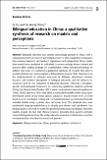Files in this item
Bilingual education in China : a qualitative synthesis of research on models and perceptions
Item metadata
| dc.contributor.author | Liu, Qi | |
| dc.contributor.author | Chong , Sin Wang | |
| dc.date.accessioned | 2023-03-13T17:30:02Z | |
| dc.date.available | 2023-03-13T17:30:02Z | |
| dc.date.issued | 2023-03-07 | |
| dc.identifier | 283643815 | |
| dc.identifier | db6dd1b2-f343-4a11-b41e-80fa667f2d6d | |
| dc.identifier | 85149850050 | |
| dc.identifier.citation | Liu , Q & Chong , S W 2023 , ' Bilingual education in China : a qualitative synthesis of research on models and perceptions ' , Applied Linguistics Review , vol. Ahead of print . https://doi.org/10.1515/applirev-2022-0194 | en |
| dc.identifier.issn | 1868-6311 | |
| dc.identifier.other | ORCID: /0000-0002-4519-0544/work/130659822 | |
| dc.identifier.uri | https://hdl.handle.net/10023/27177 | |
| dc.description.abstract | Bilingual education has become increasingly popular in China, with a subsequent growth in research, particularly research with a qualitative component that examines learners’ and teachers’ experiences and perspectives. These studies have mostly been conducted in individual classroom settings where contexts and learners differ, making findings less transferrable to other educational settings. To address this need, we conducted a qualitative synthesis of research that aims to provide a holistic and rich description of bilingual education in China. Our focus is on the implementation of bilingual education in different educational contexts, learners’ and teachers’ perceptions of bilingual education, and the research instruments used for the evaluation of bilingual education. Following a discipline-specific methodological framework for conducting qualitative research synthesis (Chong, Sin Wang & Luke Plonsky. 2021. 'A primer on qualitative research synthesis in TESOL'. TESOL Quarterly 55(3). 1024–1034), we identified suitable studies using a pre-determined search string within various databases. Search results were screened based on a set of inclusion criteria and relevant information was extracted from the included studies using a piloted data extraction form. The extracted data were synthesised using grounded theory to identify new themes and sub-themes. Our findings point to the need for more fine-grained classifications of bilingual education models, despite the fact that Chinese learners generally show positive attitudes towards bilingual education. The study ends with an analysis of limitations, as well as recommendations for future research and practice. | |
| dc.format.extent | 23 | |
| dc.format.extent | 1701995 | |
| dc.language.iso | eng | |
| dc.relation.ispartof | Applied Linguistics Review | en |
| dc.subject | Bilingual education | en |
| dc.subject | China | en |
| dc.subject | Qualitative synthesis of research | en |
| dc.title | Bilingual education in China : a qualitative synthesis of research on models and perceptions | en |
| dc.type | Journal article | en |
| dc.contributor.institution | University of St Andrews. International Education Institute | en |
| dc.identifier.doi | 10.1515/applirev-2022-0194 | |
| dc.description.status | Peer reviewed | en |
This item appears in the following Collection(s)
Items in the St Andrews Research Repository are protected by copyright, with all rights reserved, unless otherwise indicated.

